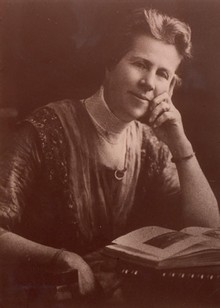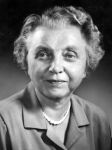
Stefan Banach was a Polish mathematician who is generally considered one of the 20th century's most important and influential mathematicians. He was the founder of modern functional analysis, and an original member of the Lwów School of Mathematics. His major work was the 1932 book, Théorie des opérations linéaires, the first monograph on the general theory of functional analysis.

Sofya Vasilyevna Kovalevskaya, born Korvin-Krukovskaya, was a Russian mathematician who made noteworthy contributions to analysis, partial differential equations and mechanics. She was a pioneer for women in mathematics around the world – the first woman to obtain a doctorate in mathematics, the first woman appointed to a full professorship in northern Europe and one of the first women to work for a scientific journal as an editor. According to historian of science Ann Hibner Koblitz, Kovalevskaya was "the greatest known woman scientist before the twentieth century".

Grace Chisholm Young was an English mathematician. She was educated at Girton College, Cambridge, England and continued her studies at Göttingen University in Germany, where in 1895 she received a doctorate. Her early writings were published under the name of her husband, William Henry Young, and they collaborated on mathematical work throughout their lives. For her work on calculus (1914–16), she was awarded the Gamble Prize for Mathematics by Girton College.
Walter Rudin was an Austrian-American mathematician and professor of Mathematics at the University of Wisconsin–Madison.

Irmgard Flügge-Lotz, née Lotz was a German-American mathematician and aerospace engineer. She was a pioneer in the development of the theory of discontinuous automatic control, which has found wide application in hysteresis control systems; such applications include guidance systems, electronics, fire-control systems, and temperature regulation. She became the first female engineering professor at Stanford University in 1961 and the first female engineer elected a Fellow of the American Institute of Aeronautics and Astronautics.

Florence Marie Mears was a professor of Mathematics at The George Washington University.

Alexandra Bellow is a Romanian-American mathematician, who has made contributions to the fields of ergodic theory, probability and analysis.

Louise Hay was a French-born American mathematician. Her work focused on recursively enumerable sets and computational complexity theory, which was influential with both Soviet and US mathematicians in the 1970s. When she was appointed head of the mathematics department at the University of Illinois at Chicago, she was the only woman to head a math department at a major research university in her era.
Edith Hirsch Luchins was a Polish-American mathematician. Her work focused on applying mathematical principles to problems in the philosophy of science and psychology, most notably in the field of Gestalt psychology. The Luchins and Luchins' Water Jar Experiment is named after her and psychologist Abraham S. Luchins.
Erica Nicole Walker is an American mathematician and the Clifford Brewster Upton Professor of Mathematics Education at Teachers College, Columbia University, where she also serves as the Chairperson of the Department of Mathematics, Science, and Technology and as the Director of the Institute for Urban and Minority Education. Walker’s research focuses on the "social and cultural factors as well as educational policies and practices that facilitate mathematics engagement, learning and performance, especially for underserved students".
Jacqueline M. Dewar is an American mathematician and mathematics educator known for her distinguished teaching and her mentorship of women in mathematics. She is a professor emerita of mathematics at Loyola Marymount University.

Marta Cavallo Bunge was an Argentine-Canadian mathematician specializing in category theory, and known for her work on synthetic calculus of variations and synthetic differential topology. She was a professor emeritus at McGill University.

Elaine H. Koppelman Eugster was an American mathematician. She was the James Beall Professor of Mathematics at Goucher College.
Svetlana A. Roudenko is a Russian-American mathematician known for her work in functional analysis and partial differential equations, and in particular in scattering theory and nonlinear Schrödinger equations. She is also known for her mentorship of women in mathematics, and is a Diversity Mentor Professor and professor of mathematics and statistics at Florida International University.
Pauline E. Mellon is an Irish mathematician who works as a professor of mathematics at University College Dublin. Her research specialties include functional analysis, the theory of Banach spaces, and the symmetries of manifolds. From 2019 to 2020 she was president of the Irish Mathematical Society and has been a member of the Royal Irish Academy's Physical, Chemical and Mathematical Sciences committee.

Renate Luise Brümmer is a Swiss-born German meteorological scientist and former astronaut. Specialising in satellite meteorology, she was selected as an astronaut in 1987, retiring in 1993, having never been into space.
Carol Smith Schumacher is a Bolivian-born American mathematician specializing in real analysis, a mathematics educator, and a textbook author. She is a professor of mathematics at Kenyon College, and vice president of the Mathematical Association of America.
Erich Hans Rothe was a German-born American mathematician, who did research in mathematical analysis, differential equations, integral equations, and mathematical physics. He is known for the Rothe method used for solving evolution equations.

Aline Huke Frink was an American mathematician, and a professor on the faculty of the Pennsylvania State University from 1930 to 1969.
Danuta Przeworska-Rolewicz, was a Polish professor of mathematics and long-time employee of the Institute of Mathematics of the Polish Academy of Sciences. During World War II, as a child, she was a resistance fighter.













